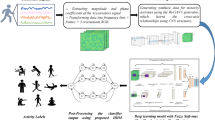Abstract
The recent advancement of deep learning methods has seen a significant increase in recognition accuracy in many important applications such as human activity recognition. However, deep learning methods require a vast amount of sensor data to automatically extract the most salient features for activity classification. Therefore, in this paper, a unified generative model is proposed to generate verisimilar data of different activities for activity recognition. The proposed generative model not only able to generate data that have a similar pattern, but also data with diverse characteristics. This allows for data augmentation in activity classification to improve the overall recognition accuracy. Three similarity measures are proposed to assess the quality of the synthetic data in addition to two visual evaluation methods. The proposed generative model was evaluated on a public dataset. The training data was prepared by systematically varying the combination of original and synthetic data. Results have shown that classification using the hybrid training data achieved a comparable recognition accuracy with the classification using the original training data. The performance of the classifiers maintained at the recognition accuracy of 85%.




Similar content being viewed by others
Explore related subjects
Discover the latest articles and news from researchers in related subjects, suggested using machine learning.References
Abadi M, Agarwal A, Barham P, Brevdo E, Chen Z, Citro C, Corrado GS, Davis A, Dean J, Devin M, Ghemawat S, Goodfellow I, Harp A, Irving G, Isard M, Jia Y, Jozefowicz R, Kaiser L, Kudlur M, Levenberg J, Mané D, Monga R, Moore S, Murray D, Olah C, Schuster M, Shlens J, Steiner B, Sutskever I, Talwar K, Tucker P, Vanhoucke V, Vasudevan V, Viégas F, Vinyals O, Warden P, Wattenberg M, Wicke M, Yu Y, Zheng X (2016) Tensorflow: large-scale machine learning on heterogeneous distributed systems. Software available from https://www.tensorflow.org
Alzantot M, Chakraborty S, Srivastava M (2017) SenseGen: A deep learning architecture for synthetic sensor data generation. IEEE Int Conf Pervasive Comput Commun Workshops PerCom Workshops. https://doi.org/10.1109/PERCOMW.2017.7917555
Banos O, Garcia R, Holgado-terriza JA, Damas M, Pomares H, Rojas I, Saez A, Villalonga C (2014) mHealthDroid: a novel framework for agiledevelopment of mobile health applications
Bolelli F, Pollastri F, Paredes R, Grana C (2018) Improving skin lesion segmentation with generative adversarial networks. Proc IEEE Symp Comput Based Med Syst. https://doi.org/10.1109/CBMS.2018.00086
Frid-Adar M, Klang E, Amitai M, Goldberger J, Greenspan H (2018) Synthetic data augmentation using GAN for improved liver lesion classification. Proc Int Symp Biomed Imaging. https://doi.org/10.1109/ISBI.2018.8363576
Gan W (2017) Wasserstein generative adversarial network. Int Conf Mach Learn. https://doi.org/10.1080/15563650600584519
Goodfellow IJ, Pouget-Abadie J, Mirza M, Xu B, Warde-Farley D, Ozair S, Courville A, Bengio Y (2014) Generative adversarial networks
Lima JLP, Macêdo D, Zanchettin C (2019) Heartbeat anomaly detection using adversarial oversampling
Liu D, Fu J, Qu Q, Lv J (2019) BFGAN: backward and forward generative adversarial networks for lexically constrained sentence generation. IEEE/ACM Trans Audio Speech Lang Process 27:2350–2361. https://doi.org/10.1109/TASLP.2019.2943018
Mirza M, Osindero S (2014) Conditional generative adversarial nets
Norgaard S, Saeedi R, Sasani K, Gebremedhin AH (2018) Synthetic sensor data generation for health applications: a supervised deep learning approach. Proc Ann Int Conf IEEE Eng Med Biol Soc. https://doi.org/10.1109/EMBC.2018.8512470
Pan Z, Yu W, Yi X, Khan A, Yuan F, Zheng Y (2019) Recent progress on generative adversarial networks (GANs): a survey. IEEE Access 7:36322–36333. https://doi.org/10.1109/ACCESS.2019.2905015
Panwar M, Ram Dyuthi S, Chandra Prakash K, Biswas D, Acharyya A, Maharatna K, Gautam A, Naik GR (2017) CNN based approach for activity recognition using a wrist-worn accelerometer. Proc Ann Int Conf IEEE Eng Med Biol Soc. https://doi.org/10.1109/EMBC.2017.8037349
Prati A, Shan C, Wang KI-K (2019) Sensors, vision and networks: From video surveillance to activity recognition and health monitoring. J Ambient Intell Smart Environ 11:5–22. https://doi.org/10.3233/AIS-180510
Qi J, Yang P, Waraich A, Deng Z, Zhao Y, Yang Y (2018) Examining sensor-based physical activity recognition and monitoring for healthcare using Internet of Things: a systematic review. J Biomed Inform 87:138–153. https://doi.org/10.1016/j.jbi.2018.09.002
Ramasamy SR, Roy N (2018) Recent trends in machine learning for human activity recognition—A survey. Wiley Interdiscip Rev 8:1–16. https://doi.org/10.1002/widm.1254
Rueda FM, Grzeszick R, Fink GA, Feldhorst S, Ten Hompel M (2018) Convolutional neural networks for human activity recognition using body-worn sensors. Informatics 5:1–17. https://doi.org/10.3390/informatics5020026
Shi D, Wang R, Wu Y, Mo X, Wei J (2017) A novel orientation- and location-independent activity recognition method. Pers Ubiquit Comput 21:427–441. https://doi.org/10.1007/s00779-017-1007-3
Sun X, He J (2020) A novel approach to generate a large scale of supervised data for short text sentiment analysis. Multimed Tools Appl 79:5439–5459. https://doi.org/10.1007/s11042-018-5748-4
Thakur D, Biswas S (2020) Smartphone based human activity monitoring and recognition using ML and DL: a comprehensive survey. J Ambient Intell Human Comput. https://doi.org/10.1007/s12652-020-01899-y
Tsanousa A, Meditskos G, Vrochidis S, Angelis L (2020) A novel feature selection method based on comparison of correlations for human activity recognition problems. J Ambient Intell Human Comput. https://doi.org/10.1007/s12652-020-01836-z
Wang J, Chen Y, Gu Y, Xiao Y, Pan H (2018) SensoryGANs: an effective generative adversarial framework for sensor-based human activity recognition. Proc Int Joint Conf Neural Netw. https://doi.org/10.1109/IJCNN.2018.8489106
Yi X, Walia E, Babyn P (2019) Generative adversarial network in medical imaging: a review. Med Image Anal 58:101552. https://doi.org/10.1016/j.media.2019.101552
Zhang H, Xu T, Li H, Zhang S, Wang X, Huang X, Metaxas DN (2019) StackGAN++: realistic image synthesis with stacked generative adversarial networks. IEEE Trans Pattern Anal Mach Intell 41:1947–1962. https://doi.org/10.1109/TPAMI.2018.2856256
Acknowledgements
This work has been was supported in part by the Universiti Sains Malaysia under Short Term Grant 304/PKOMP/6315206.
Author information
Authors and Affiliations
Corresponding author
Additional information
Publisher's Note
Springer Nature remains neutral with regard to jurisdictional claims in published maps and institutional affiliations.
Rights and permissions
About this article
Cite this article
Chan, M.H., Noor, M.H.M. A unified generative model using generative adversarial network for activity recognition. J Ambient Intell Human Comput 12, 8119–8128 (2021). https://doi.org/10.1007/s12652-020-02548-0
Received:
Accepted:
Published:
Issue Date:
DOI: https://doi.org/10.1007/s12652-020-02548-0




